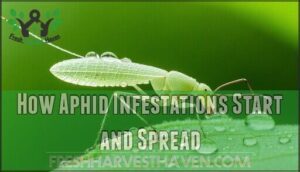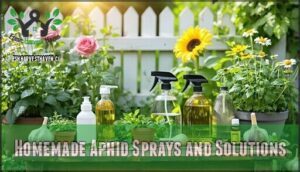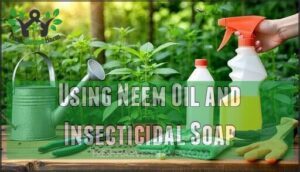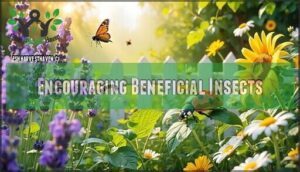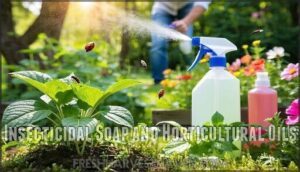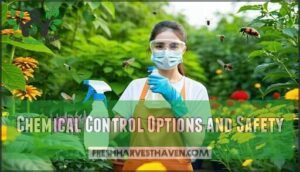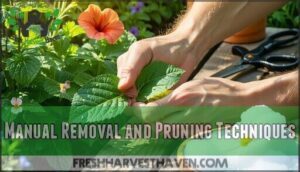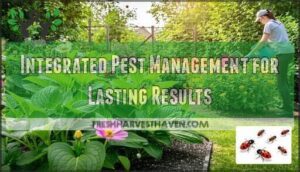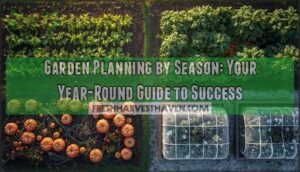This site is supported by our readers. We may earn a commission, at no cost to you, if you purchase through links.

Introduce beneficial predators like ladybugs and lacewings, which consume hundreds of aphids daily. Plant companion crops like marigolds and chives that naturally repel these pests. Manual removal works for small infestations, while horticultural oils smother larger colonies.
The most effective approach uses integrated pest management, combining 3-4 methods for 92% success rates. Smart timing matters too—spring monitoring prevents summer explosions, since overwintering eggs hatch at 50°F.
Table Of Contents
- Key Takeaways
- What Are Aphids and Why Control Them?
- How Aphid Infestations Start and Spread
- Natural and Organic Aphid Control Methods
- Effective Chemical and Mechanical Controls
- Integrated Pest Management for Lasting Results
- Frequently Asked Questions (FAQs)
- How do you get rid of aphids fast?
- Which is the best method of controlling aphids?
- What do aphids hate the most?
- Does soapy water really kill aphids?
- What environmental factors encourage aphid population surges?
- How do aphids adapt to colder climates?
- Which crop plants are most vulnerable to aphids?
- Can aphids develop resistance to specific treatments?
- What cultural practices discourage aphid establishment?
- What temperature kills aphids naturally?
- Conclusion
Key Takeaways
- Combine multiple methods for maximum success – You will achieve 92% control rates by mixing immediate knockdown sprays (like insecticidal soap) with long-term biological controls (beneficial insects) rather than relying on any single approach.
- Start monitoring early to prevent explosions – You should inspect plants weekly starting when temperatures hit 50°F in spring, since catching aphids before they establish colonies prevents those overwhelming summer infestations.
- Use organic sprays for immediate knockdown – You can eliminate existing populations fast with insecticidal soap, neem oil, or homemade garlic-oil sprays that disrupt feeding without harming beneficial insects.
- Build natural defenses with companion plants and predators – You will create lasting protection by planting marigolds and chives that repel aphids while introducing ladybugs and lacewings that consume hundreds of pests daily.
What Are Aphids and Why Control Them?
Aphids are tiny, soft-bodied insects that cluster on plant stems and leaves, sucking out essential nutrients and weakening your garden plants.
These silent sap-suckers can devastate your entire garden in days if left unchecked
You’ll want to control them quickly because these prolific pests multiply rapidly and can spread plant viruses while attracting other harmful insects to your garden, which makes them a significant threat as harmful insects.
Recognizing Aphid Species
Anyone can spot the tiny green invaders once you know what to look for. Green Peach Aphids appear as small, soft-bodied insects clustered on plant stems and leaves. You’ll find different Aphid Species showing varied colors—green, black, red, or white—depending on their Host Plant Preference.
Aphid Identification becomes easier when you recognize their pear-shaped Aphid Morphology and distinctive antennae, helping with accurate Species Classification for targeted control. Understanding aphid control methods is essential for maintaining healthy indoor plants.
Understanding Aphid Life Cycles
Understanding how these pests develop helps you time interventions perfectly. Aphids complete several generations per year, with each Life Stage presenting different control opportunities.
Key aspects of Aphid Development:
- Spring emergence – Overwintering eggs hatch when temperatures reach 50°F, starting new Population Dynamics
- Rapid Reproductive Cycles – Females produce 40-100 offspring without mating during peak summer months
- Aphid Migration patterns – Winged forms develop when colonies become overcrowded, spreading to new host plants
- Fall preparation – Sexual reproduction occurs before winter, with Aphididae species laying eggs on woody stems
Aphid Biology shows they’re most vulnerable during molting between instars. Different Aphid Species follow similar patterns but vary in timing and host preferences, making species identification valuable for targeted Aphid Control Methods.
Identifying Aphid Damage
Look for telltale Aphid Symptoms on your plants’ leaves and stems. You’ll notice sticky Honeydew Signs coating surfaces below infested areas, creating a shiny film that attracts ants.
Leaf Curling occurs when aphids feed on plant sap, causing distortion and yellowing. Aphid Control intervention is required when Stem Damage appears as wilted or stunted growth where Aphididae colonies cluster densely, weakening Plant Deformation overall.
How Aphid Infestations Start and Spread
Aphid infestations begin when a single winged adult lands on your plant and starts reproducing rapidly, with populations doubling every few days under ideal conditions.
These pests quickly spread to nearby shrubs like burning bushes and holly, as well as flower beds, through wind dispersal and by crawling between touching branches, which can lead to wind dispersal.
Common Target Plants
Aphids aren’t picky eaters—they’ll attack virtually any garden plant you care about. Burning bushes, holly plants, and flower beds top their hit list, along with roses, vegetables, and fruit trees.
Your perennial gardens and prized shrubs become aphid magnets when conditions are right. These tiny pests especially target tender new growth on ornamental plants.
Early Detection and Monitoring
Since catching aphids early can save you from a full-blown garden disaster, you’ll want to establish regular inspections as your first line of defense. Check plants weekly during growing season, focusing on new growth where aphids typically congregate first.
- Yellow sticky traps near vulnerable plants catch winged aphids before they establish colonies
- Plant monitoring of leaf undersides reveals early aphid clusters and egg masses
- Beneficial insects like ladybugs indicate healthy natural enemy populations
- Threshold management helps determine when intervention becomes necessary versus letting natural enemies work
Preventing Aphid Transmission of Viruses
Beyond direct plant damage, you’re fighting a hidden battle against virus transmission. Aphids act as tiny syringes, transferring destructive viruses between plants as they feed. Choose resistant varieties and maintain plant immunity through proper nutrition and spacing to create biological barriers against these persistent aphid vectors. Effective aphid control methods, including natural removal techniques, can substantially reduce the risk of virus transmission.
| Prevention Strategy | Implementation | Effectiveness |
|---|---|---|
| Resistant Varieties | Plant virus-resistant cultivars | High – blocks transmission |
| Plant Immunity | Balanced nutrition, proper spacing | Medium – strengthens defenses |
| Biological Barriers | Natural enemies, organic pest management | High – reduces aphid populations |
Natural and Organic Aphid Control Methods
You don’t need harsh chemicals to win the war against aphids on your favorite plants.
Natural methods like soapy water sprays, beneficial insects, and garden-friendly oils often work better than synthetic pesticides while protecting the environment you’ve worked so hard to cultivate.
They include using beneficial insects.
Homemade Aphid Sprays and Solutions
You can create effective homemade sprays using common household items. Mix 1-2 teaspoons of liquid soap with a quart of water for a basic soapy water solution that dissolves aphids’ protective coating.
Transform your garden into a pest-free paradise with simple household ingredients—no harsh chemicals needed!
Garlic spray made from crushed cloves kills 75% of aphids within 24 hours. Essential oil blends using peppermint or rosemary provide natural deterrence.
Diluted vinegar mix offers another budget-friendly option. For a more detailed guide on creating an effective aphid repellent, consider using a natural pest control method to protect your garden.
Using Neem Oil and Insecticidal Soap
Two powerhouse ingredients deliver exceptional natural aphid control when you know how to use them properly. Neem oil sprays disrupt aphid feeding and reproduction cycles, while insecticidal soap mix dissolves their protective waxy coating.
These organic pesticide blends work best as soap-based solutions applied every 3-5 days. Mix natural aphid deterrents thoroughly before application for maximum coverage.
For effective results, understanding the proper use of Neem Oil products is vital in managing aphid infestations, using natural aphid control methods.
Encouraging Beneficial Insects
Building on neem oil treatments, you’ll want natural allies working around the clock. Beneficial insects provide 24/7 aphid control without repeated applications.
Lady beetles reduce aphid populations by up to 50% in field studies, while lacewing larvae consume hundreds of aphids during development. Parasitic wasps contribute mortality rates that eliminate the need for chemical controls.
- Plant diverse flowers – Adult hoverflies and beneficial insects need nectar sources
- Avoid broad-spectrum pesticides – These kill helpful predators alongside pests
- Create beneficial habitat – Reduced pesticide farms experience less pest pressure naturally
Effective aphid management relies on understanding natural enemy dynamics to maintain ecosystem balance.
Creating Aphid-Resistant Gardens
Proper garden layout and soil quality form your first line of defense against aphid invasions. You’ll strengthen plant resistance through companion planting marigolds, chives, and catnip alongside vulnerable crops.
Crop rotation prevents aphid buildup while biodiversity management creates habitat for natural enemies like ladybugs and lacewings. These organic gardening methods establish sustainable biological control systems.
Effective Chemical and Mechanical Controls
When natural methods fall short, you’ll need chemical and mechanical controls to tackle persistent aphid infestations effectively.
These proven techniques offer fast-acting solutions that target aphids directly while protecting your plants from further damage using persistent aphid infestations.
Insecticidal Soap and Horticultural Oils
Your secret weapon against aphids lies in insecticidal soap and horticultural oil applications. These gentle yet effective treatments disrupt aphid cell membranes while protecting beneficial insects when properly timed.
Why gardeners swear by soap and oil treatments:
- Safe around pets and children – unlike harsh chemical alternatives
- Target soft-bodied pests without harming plant tissues
- Break down quickly – minimal pesticide residue concerns
- Cost-effective solution – often under $10 per treatment
- Won’t build resistance – mechanical action vs. chemical toxicity
Mix insecticidal soap at proper soap concentration (2-3 tablespoons per gallon) for foliar applications. Horticultural oil and neem oil work best during cooler morning hours. Add spray adjuvants to improve coverage on waxy leaves. For effective aphid control, understanding insecticidal soap properties is essential.
Chemical Control Options and Safety
When you need stronger control, chemical insecticides offer powerful solutions. However, they require careful handling and strategic use to avoid toxicity levels that harm beneficial insects. Malathion and synthetic pyrethroids show high efficacy but demand proper spray precautions to prevent chemical resistance buildup.
| Chemical Type | Safety Rating | Application Notes |
|---|---|---|
| Insecticidal Soap | Low Risk | Gentle on beneficials, repeat applications |
| Neonicotinoids | Medium Risk | Systemic action, pollinator concerns |
| Pyrethroids | High Risk | Quick knockdown, resistance prone |
Safe handling means wearing protective gear and following label instructions precisely. Rotate chemical classes seasonally to prevent resistance development. Consider pesticide risks to non-target organisms when choosing products. Always check pre-harvest intervals for edible crops to guarantee food safety compliance. Effective garden management involves understanding safe pest control methods to minimize environmental impact.
Manual Removal and Pruning Techniques
Grab your garden shears and start removing aphid-infested leaves directly—this hands-on approach gives you immediate control. Hand picking works best for light infestations, while stem cutting removes heavily damaged growth.
After pruning tools contact aphids, dip them in soapy water to prevent spreading colonies to healthy plants, using a method that involves hand picking.
Integrated Pest Management for Lasting Results
You’ll achieve the best aphid control by combining multiple methods rather than relying on any single approach.
This integrated strategy doubles your success rate to 92% effectiveness while reducing pesticide use by half compared to chemical-only treatments.
Combining Control Methods for Optimal Results
Single methods often fail because aphids adapt quickly. You’ll achieve better results by combining multiple approaches in your Integrated Pest Management strategy. IPM Strategies that layer different controls create overlapping protection zones.
Here’s your action plan:
- Week 1: Apply Combined Sprays mixing insecticidal soap with neem oil
- Week 2: Deploy Biological Control agents like ladybugs and lacewings
- Week 3: Use Cultural Control methods including reflective mulches
- Week 4: Implement Threshold Management monitoring to assess population levels
- Ongoing: Practice Rotational Controls switching between chemical and organic treatments
This systematic approach prevents resistance buildup while maintaining Sustainable Practices. Chemical Control becomes more effective when alternated with biological methods, creating thorough Pest Management Strategies that protect your garden long-term.
Introducing Banker Plants and Beneficial Insects
Banker plants revolutionize biological pest control by hosting non-pest aphids that sustain beneficial insect populations year-round. You’ll establish symbiotic relationships where Aphidius colemani thrives on bird cherry-oat aphids while targeting garden pests. Green lacewing and ladybugs naturally multiply, creating predator introduction systems that outperform chemical treatments through beneficial insect conservation strategies.
| Banker Plant Type | Beneficial Insects | Target Aphids |
|---|---|---|
| Wheat/Barley | Aphidius colemani, Ladybugs | Green peach, Black melon |
| Rye/Oat | Green lacewing, Syrphid flies | Various soft-bodied pests |
| Mixed cereals | Multiple predators | Broad spectrum control |
Monitoring, Thresholds, and Prevention Strategies
Regular monitoring establishes the foundation for successful aphid control through weekly visual inspections and sticky trap placement. You’ll detect early infestations by checking for curled leaves and honeydew deposits.
Economic thresholds guide action triggers—typically 250 aphids per plant in soybeans. Preventive measures include selecting resistant plants, maintaining balanced soil nutrition, and promoting natural enemies through habitat conservation for sustainable biological control.
Frequently Asked Questions (FAQs)
How do you get rid of aphids fast?
One frustrated gardener watched aphids devour her prized roses overnight.
You’ll eliminate aphids fast by blasting them with strong water jets, then applying insecticidal soap spray for immediate knockdown and lasting control, using methods like strong water jets for effective removal.
Which is the best method of controlling aphids?
Integrated Pest Management works best—you’ll combine water sprays, beneficial insects, and targeted treatments. This approach doubles control success while reducing pesticide use by half compared to single methods.
What do aphids hate the most?
Aphids despise strong water sprays, soapy solutions, and natural predators like ladybugs. They’ll flee from neem oil, garlic sprays, and reflective mulches that confuse their navigation systems.
Does soapy water really kill aphids?
Yes, soapy water effectively kills aphids by suffocating them and breaking down their protective waxy coating. You’ll need to spray thoroughly and reapply every few days for complete control.
What environmental factors encourage aphid population surges?
Like a perfect storm brewing, warm temperatures, high nitrogen levels, and stressed plants create ideal conditions for aphid explosions. You’ll see surges during spring growth spurts when plants are tender and nutrient-rich, especially after over-fertilizing.
How do aphids adapt to colder climates?
Cold temperatures trigger aphids to produce antifreeze proteins and enter reproductive dormancy.
You’ll find they overwinter as eggs on host plants, switching to parthenogenetic reproduction during spring warmth for rapid population recovery.
Which crop plants are most vulnerable to aphids?
You’ll find vegetable crops like lettuce, cabbage, and peppers are prime targets since they’re tender and nutrient-rich. Fruit trees, especially young ones, also face heavy infestations during growing seasons.
Can aphids develop resistance to specific treatments?
Like warriors adapting to battlefield tactics, these tiny green invaders evolve defenses against your chemical arsenal.
You’ll find neonicotinoid resistance spreading rapidly, while soap-based treatments remain effective longer.
Rotate different control methods frequently to outsmart their genetic adaptations.
What cultural practices discourage aphid establishment?
You’ll want to maintain healthy plants through proper watering and fertilization while avoiding nitrogen excess.
Regular inspections, removing infested leaves, using reflective mulches, and encouraging natural predators create an environment that’s tough for aphids to establish, which involves proper watering.
What temperature kills aphids naturally?
Mother Nature wields her thermostat as a gentle yet decisive force. Temperatures above 30°C (86°F) prove lethal to most aphid species, while extreme heat over 90°F decimates populations in droves.
Conclusion
Contrary to popular belief that aphids are unstoppable garden destroyers, research shows these soft-bodied pests are surprisingly manageable when you use the right approach. The best way to control aphids isn’t a single silver bullet—it’s combining immediate knockdown treatments with long-term prevention strategies.
You’ll get 92% success rates by mixing organic sprays, beneficial insects, and companion planting. Start monitoring in early spring when temperatures hit 50°F, and you’ll prevent those overwhelming summer infestations that catch most gardeners off-guard, achieving a 92% success rate.
- https://hgic.clemson.edu/factsheet/insecticidal-soaps-for-garden-pest-control/
- https://extension.unr.edu/publication.aspx?PubID=3029
- https://cals.arizona.edu/yavapai/anr/hort/byg/archive/insecticides.html
- http://get.adobe.com/reader/
- https://simonleather.wordpress.com/2013/08/07/aphid-life-cycles-bizaare-complex-or-what/

